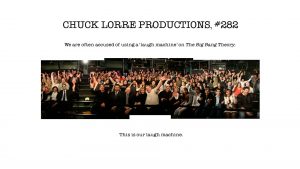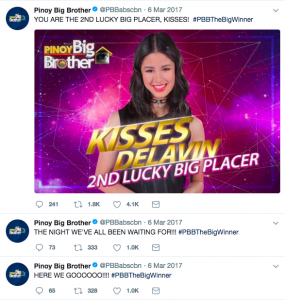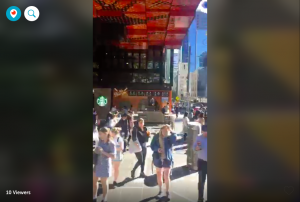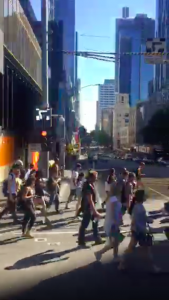Collaboration in the studio
How do you feel you went in your role?
I was assigned to two different types of roles, the second one being a last minute decision in order to help a group out that lacked group members. My first role of the day was the Vision Mixer! For those unfamiliar with what a vision mixer does, you could also call me an Editor. What my role composes of is basically the switching of screens – what the audience saw on the live screen but also the point of view of all three cameras. This gives myself and the director the opportunity to correct any potential errors and get the desired shot that we want. My performance in this role was somewhat subpar, only because I was not used to the various stimuli going on around me. I realised I had to focus on three things at a time – both the screen, script and audio. I totally underestimated the expectations and roles of a vision mixer. Nonetheless, it was still a good learning experience and I was able to soak in a lot of information, especially as a Vision Mixer.
The second role I got was in charge of Audio! You could say that I was an audio mixer (lol?), however, it did not hold as many responsibilities as it did in comparison to the role of a vision mixer. My main responsibilities were ensuring the talents’ microphones were working and that the right microphones were given to the right person. A fun fact that I’ve learnt on set today was that there were certain microphones assigned to each of the talents (in this case to the two of them), depending on their positioning. I was then showed the complexities of the audio mixer and how each dial is connected to a certain part of the machine to the next. It’s easier to explain in real life, I swear. Other than that, I found operating on the audio fairly easy and manageable. Having already been in the studio beforehand with the Unbreakable Kimmy Schmidt skit, I got the gist of the studio operations for my second try as a sound operator.
What were the differences to other media productions you’ve crewed on?
(Screengrab taken on 24th of March)
I have only crewed in one studio show and that is the production of In Pit Lane, under RMITV Studios. Located in Building 10, the show goes live every Tuesdays at 9 PM. Most of the crew members are well-seasoned veterans and are fully knowledgeable about what goes on during the live television – the show has been airing for over twenty-two years! The difference between this studio class and the In Pit Lane production that I’ve crewed on is that everyone is a beginner in this class whilst everyone in the professional studio is well, a professional.
In this studio class, it was a less stressful environment and was, therefore, a more comfortable environment to make mistakes – as a first-time vision mixer, I definitely made a mistake or two (or even more). For In Pit Lane, I was assigned as the camera operator and will continue to be my role for the remainder of the show. Despite it being officially live, I definitely felt the pressure as a camera operator but was also a good experience because everyone around me was extremely helpful. All in all, the ultimate difference was that in this studio, we were at the beginning of our studio journey whilst the people around me in In Pit Lane were already experienced.
Do the different crew roles interact and collaborate?
Definitely. From the control room to the actual studio itself, we all communicated to one another. Some examples of the roles that required constant communication was the role of the Director to the Vision Mixer. Correct me if I’m wrong but I believe that both Lizzie (the director) and I required the most interaction and communication with one another, especially when she was instructing me when to switch the camera whilst following the script. Essentially, the director has communication with all the roles within the studio, communicating with the roles in the control room and on the floor.
I would say that the second most important roles are the Director’s Assistant and the Floor Manager – they are both the leading roles that keep the Director in check, whilst also managing the various roles that form the studio altogether. Without these leadership positions, communication would be hard to come by, especially in a studio where the directors, talents, camera operators, etc aren’t together in one room.
So in essence, the different crew roles do interact one way or another, even if some of these roles are unrelated. I was privileged enough to be paired with a group that were lovely to work with, some of them being my friends from my first year of my media course.
What was it like watching as an audience member?
From the readings of Giotta and Gadassik, it heavily discusses the importance of the response from the audience. Giotta mentions the that the presence of a live audience became integral to live television, only because it helped home viewers interpret the content on television. As an audience member for the other groups, I felt all of us had a role to play as an audience – to spectate and react. Even though none of the talents were professional actors/actresses, the lines of the script still ignited laughter from the audience, giving the crew members a sign that we were on the right track.
I also pondered about Gadassik’s reading and how the audience is always looking for something controversial or natural to happen. As an audience member, it would have been definitely interesting for something amusing to happen but having also experienced crewing, I did not want anything wrong to happen. However, there is still that nature in me to think of the worst no matter what experience I have had through media. Overall, I had a great time seeing the different styles of crewing and was a knowledgeable experience to be part of.
What were the differences in shooting these scenes for multi-camera vs. single camera?
If we were to shoot this on a single camera, it would have been a much longer process to complete in comparison to the multi-camera method that we did during Thursday’s studio assignment. Roles that exist in a multi-camera studio would have definitely been eliminated if we were operating on a single camera. These roles are the vision mixer and the two other camera operators. If we also used one camera, this would make the camera operator’s job harder, forcing them to move around more and potentially getting a messier and slower footage.
It is much more convenient to be operating under a multi-camera studio, especially if it were a live program – more roles are able to assist one another and it would be a more efficient and easier process.







